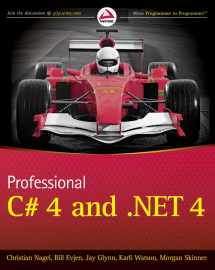
Professional C# 4.0 and .NET 4
Book details
Summary
Description
This book starts by reviewing the overall architecture of .NET in order to give you the background you need to be able to write managed code. After that, the book is divided into a number of sections that cover both the C# language and its application in a variety of areas.
Part I: The C# Language gives a good grounding in the C# language for experienced programmers. You start by looking at basic syntax and data types. Objects, types, inheritance, generics, arrays, tuples, operators, casts, delegates, lambdas, events, strings, regular expressions, collections, Language Integrated, Query (LINQ), Dynamic Language Extensions, memory management, pointers, reflection, errors, and exceptions are all covered.
Part II: Visual Studio looks at Visual Studio 2010 (the best way to use the tool to build applications based on the .NET Framework 4) and deploying your projects.
Part III: Foundation looks at .NET assemblies, instrumentation, security, threading, tasks, synchronization, localization, System.Transactions, networking, interop, XAML, Managed Extensibility Framework, Manipulating Files and the Registry, transactions, building Windows services, and generating your own libraries as assemblies.
Part IV: Data covers accessing databases with ADO.NET, ADO.NET Entity Framework, data services, support in .NET for XML, and the .NET features of SQL Server 2008.
Part V: Presentation shows how to build applications based on the Windows Presentation Foundation and Silverlight, and covers writing components that will run on web sites. It also has coverage on building Windows Forms applications in as well as ASP.NET and ASP.NET MVC.
Part VI: Communication covers services for platform-independent communication using the Windows Communication Foundation (WCF). With Message Queuing, asynchronous disconnected communication is shown. This section looks at utilizing the Windows Workflow Foundation 4, peer to peer networking, and creating syndication feeds.

We would LOVE it if you could help us and other readers by reviewing the book
Book review



